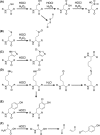Neutrophil-generated oxidative stress and protein damage in Staphylococcus aureus
- PMID: 27354296
- PMCID: PMC5975594
- DOI: 10.1093/femspd/ftw060
Neutrophil-generated oxidative stress and protein damage in Staphylococcus aureus
Abstract
Staphylococcus aureus is a ubiquitous, versatile and dangerous pathogen. It colonizes over 30% of the human population, and is one of the leading causes of death by an infectious agent. During S. aureus colonization and invasion, leukocytes are recruited to the site of infection. To combat S. aureus, leukocytes generate an arsenal of reactive species including superoxide, hydrogen peroxide, nitric oxide and hypohalous acids that modify and inactivate cellular macromolecules, resulting in growth defects or death. When S. aureus colonization cannot be cleared by the immune system, antibiotic treatment is necessary and can be effective. Yet, this organism quickly gains resistance to each new antibiotic it encounters. Therefore, it is in the interest of human health to acquire a deeper understanding of how S. aureus evades killing by the immune system. Advances in this field will have implications for the design of future S. aureus treatments that complement and assist the host immune response. In that regard, this review focuses on how S. aureus avoids host-generated oxidative stress, and discusses the mechanisms used by S. aureus to survive oxidative damage including antioxidants, direct repair of damaged proteins, sensing oxidant stress and transcriptional changes. This review will elucidate areas for studies to identify and validate future antimicrobial targets.
Keywords: Staphylococcus aureus; antioxidant defenses; host–pathogen interface; neutrophils; oxidative stress; protein oxidation.
© FEMS 2016. All rights reserved. For permissions, please e-mail: journals.permissions@oup.com.
Figures




Comment in
-
Editorial: The sum of all defenses: tolerance + resistance.Pathog Dis. 2017 Mar 1;75(2):ftx015. doi: 10.1093/femspd/ftx015. Pathog Dis. 2017. PMID: 28175285 Free PMC article. No abstract available.
References
-
- Abid N, Maalej S, Rouis S. Morphological and physiological changes of Staphylococcus aureus exposed to hypochlorous acid. Lett Appl Microbiol. 2004;38:245–50. - PubMed
-
- Amulic B, Cazalet C, Hayes GL, et al. Neutrophil function: from mechanisms to disease. Annu Rev Immunol. 2012;30:459–89. - PubMed
-
- Anderson MM, Hazen SL, Hsu FF, et al. Human neutrophils employ the myeloperoxidase-hydrogen peroxide-chloride system to convert hydroxy-amino acids into glycolaldehyde, 2-hydroxypropanal, and acrolein. A mechanism for the generation of highly reactive alpha-hydroxy and alpha,beta-unsaturated aldehydes by phagocytes at sites of inflammation. J Clin Invest. 1997;99:424–32. - PMC - PubMed
-
- Armstrong-Buisseret L, Cole MB, Stewart GS. A homologue to the Escherichia coli alkyl hydroperoxide reductase AhpC is induced by osmotic upshock in Staphylococcus aureus. Microbiology. 1995;141:1655–61. - PubMed
Publication types
MeSH terms
Substances
Grants and funding
LinkOut - more resources
Full Text Sources
Other Literature Sources
Medical

